Equity, Trust, and Will Law: Common Law, Charities, and Public Benefit
VerifiedAdded on 2022/09/12
|16
|4033
|19
Essay
AI Summary
This assignment delves into the principles of equity, trust, and will law, exploring their applications and significance in legal contexts. The first part examines the concept of equity, its historical roots, and its role in balancing legal outcomes, including the influence of conscience and the application of equity in cases like Cornerstone Property & Development Pty Ltd v Suellen Properties Pty Ltd [2014] QSC 265. The discussion covers the role of conscience, discretion, and trust in equity, as well as the impact of religion and morality. The second part focuses on charities, the public benefit requirement as outlined in the Charities Act 2006, and the role of the Charities Commission. It examines the impact of public benefit requirements on charities' reputation and funding, and the challenges faced by fee-charging charities, particularly in relation to managing risks and addressing funding issues. The assignment emphasizes the importance of these legal concepts in ensuring fairness and promoting the welfare of society.
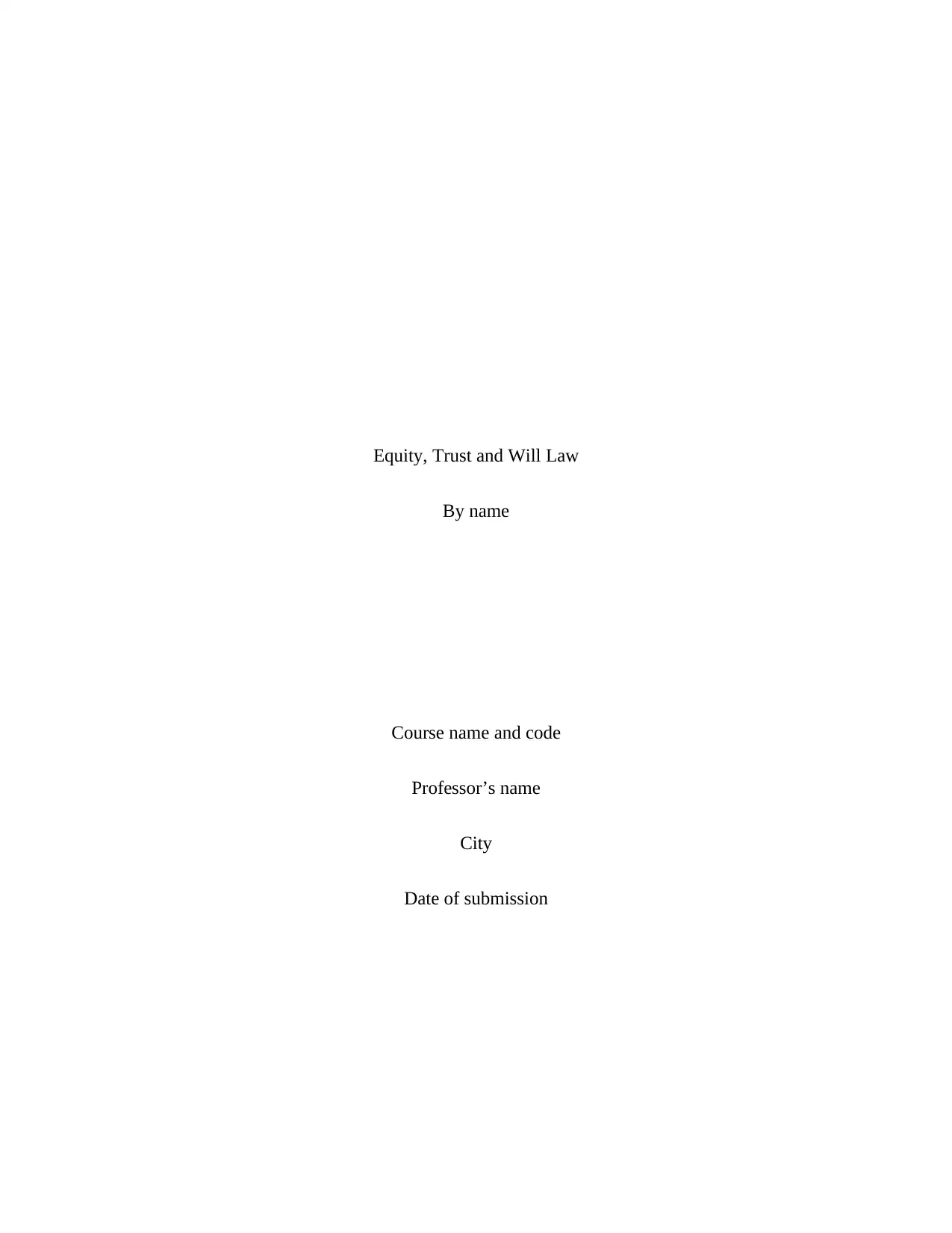
Equity, Trust and Will Law
By name
Course name and code
Professor’s name
City
Date of submission
By name
Course name and code
Professor’s name
City
Date of submission
Paraphrase This Document
Need a fresh take? Get an instant paraphrase of this document with our AI Paraphraser
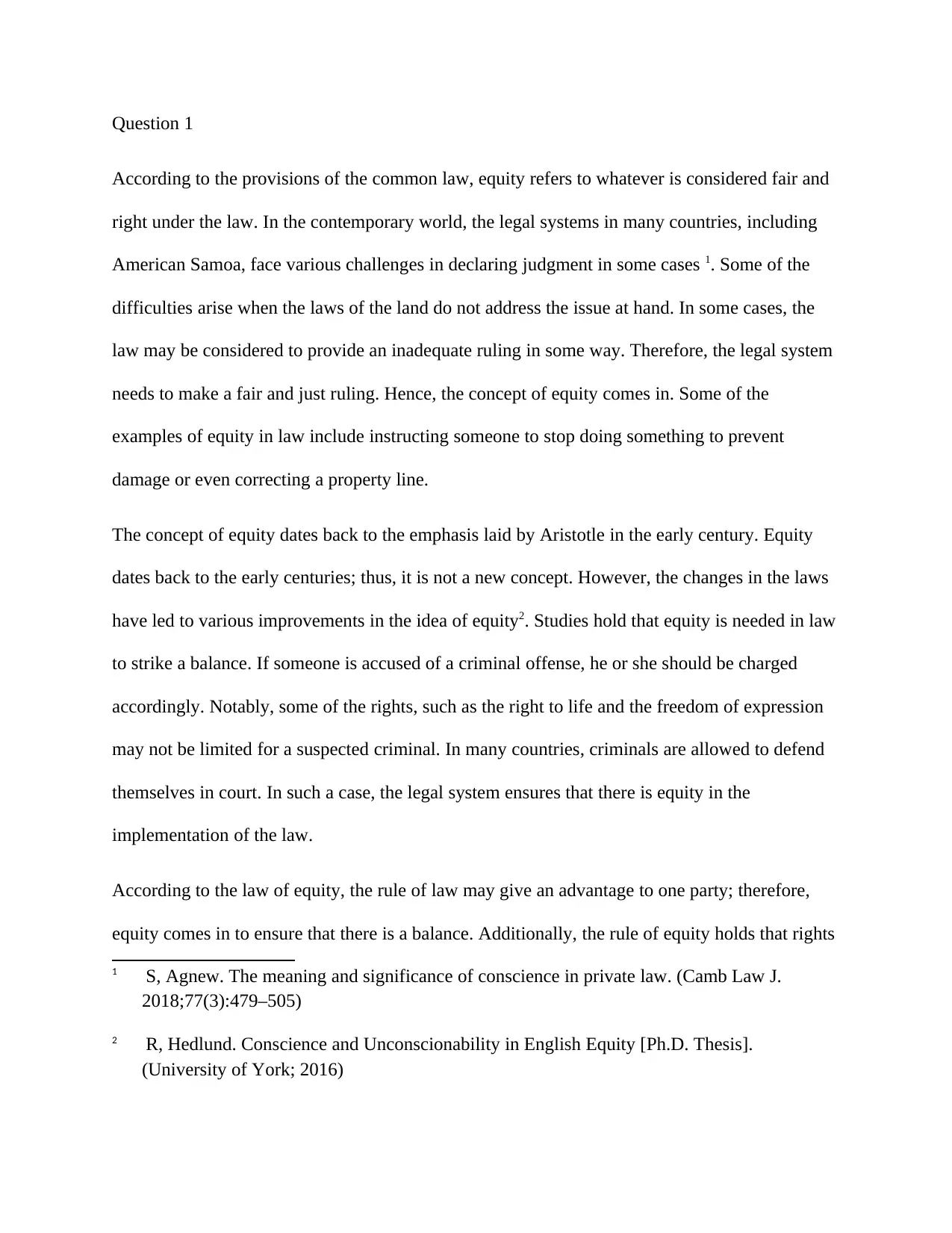
Question 1
According to the provisions of the common law, equity refers to whatever is considered fair and
right under the law. In the contemporary world, the legal systems in many countries, including
American Samoa, face various challenges in declaring judgment in some cases 1. Some of the
difficulties arise when the laws of the land do not address the issue at hand. In some cases, the
law may be considered to provide an inadequate ruling in some way. Therefore, the legal system
needs to make a fair and just ruling. Hence, the concept of equity comes in. Some of the
examples of equity in law include instructing someone to stop doing something to prevent
damage or even correcting a property line.
The concept of equity dates back to the emphasis laid by Aristotle in the early century. Equity
dates back to the early centuries; thus, it is not a new concept. However, the changes in the laws
have led to various improvements in the idea of equity2. Studies hold that equity is needed in law
to strike a balance. If someone is accused of a criminal offense, he or she should be charged
accordingly. Notably, some of the rights, such as the right to life and the freedom of expression
may not be limited for a suspected criminal. In many countries, criminals are allowed to defend
themselves in court. In such a case, the legal system ensures that there is equity in the
implementation of the law.
According to the law of equity, the rule of law may give an advantage to one party; therefore,
equity comes in to ensure that there is a balance. Additionally, the rule of equity holds that rights
1 S, Agnew. The meaning and significance of conscience in private law. (Camb Law J.
2018;77(3):479–505)
2 R, Hedlund. Conscience and Unconscionability in English Equity [Ph.D. Thesis].
(University of York; 2016)
According to the provisions of the common law, equity refers to whatever is considered fair and
right under the law. In the contemporary world, the legal systems in many countries, including
American Samoa, face various challenges in declaring judgment in some cases 1. Some of the
difficulties arise when the laws of the land do not address the issue at hand. In some cases, the
law may be considered to provide an inadequate ruling in some way. Therefore, the legal system
needs to make a fair and just ruling. Hence, the concept of equity comes in. Some of the
examples of equity in law include instructing someone to stop doing something to prevent
damage or even correcting a property line.
The concept of equity dates back to the emphasis laid by Aristotle in the early century. Equity
dates back to the early centuries; thus, it is not a new concept. However, the changes in the laws
have led to various improvements in the idea of equity2. Studies hold that equity is needed in law
to strike a balance. If someone is accused of a criminal offense, he or she should be charged
accordingly. Notably, some of the rights, such as the right to life and the freedom of expression
may not be limited for a suspected criminal. In many countries, criminals are allowed to defend
themselves in court. In such a case, the legal system ensures that there is equity in the
implementation of the law.
According to the law of equity, the rule of law may give an advantage to one party; therefore,
equity comes in to ensure that there is a balance. Additionally, the rule of equity holds that rights
1 S, Agnew. The meaning and significance of conscience in private law. (Camb Law J.
2018;77(3):479–505)
2 R, Hedlund. Conscience and Unconscionability in English Equity [Ph.D. Thesis].
(University of York; 2016)
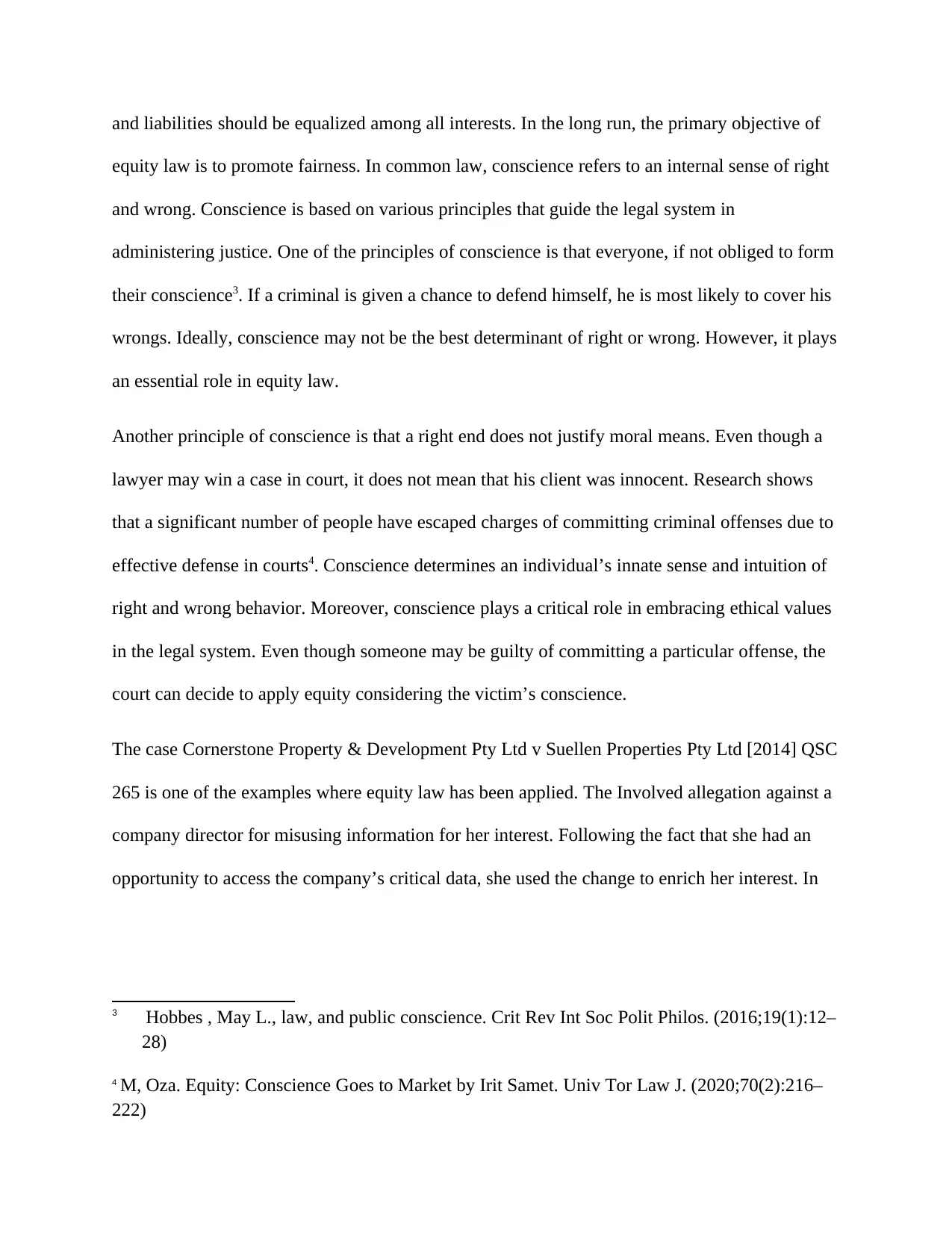
and liabilities should be equalized among all interests. In the long run, the primary objective of
equity law is to promote fairness. In common law, conscience refers to an internal sense of right
and wrong. Conscience is based on various principles that guide the legal system in
administering justice. One of the principles of conscience is that everyone, if not obliged to form
their conscience3. If a criminal is given a chance to defend himself, he is most likely to cover his
wrongs. Ideally, conscience may not be the best determinant of right or wrong. However, it plays
an essential role in equity law.
Another principle of conscience is that a right end does not justify moral means. Even though a
lawyer may win a case in court, it does not mean that his client was innocent. Research shows
that a significant number of people have escaped charges of committing criminal offenses due to
effective defense in courts4. Conscience determines an individual’s innate sense and intuition of
right and wrong behavior. Moreover, conscience plays a critical role in embracing ethical values
in the legal system. Even though someone may be guilty of committing a particular offense, the
court can decide to apply equity considering the victim’s conscience.
The case Cornerstone Property & Development Pty Ltd v Suellen Properties Pty Ltd [2014] QSC
265 is one of the examples where equity law has been applied. The Involved allegation against a
company director for misusing information for her interest. Following the fact that she had an
opportunity to access the company’s critical data, she used the change to enrich her interest. In
3 Hobbes , May L., law, and public conscience. Crit Rev Int Soc Polit Philos. (2016;19(1):12–
28)
4 M, Oza. Equity: Conscience Goes to Market by Irit Samet. Univ Tor Law J. (2020;70(2):216–
222)
equity law is to promote fairness. In common law, conscience refers to an internal sense of right
and wrong. Conscience is based on various principles that guide the legal system in
administering justice. One of the principles of conscience is that everyone, if not obliged to form
their conscience3. If a criminal is given a chance to defend himself, he is most likely to cover his
wrongs. Ideally, conscience may not be the best determinant of right or wrong. However, it plays
an essential role in equity law.
Another principle of conscience is that a right end does not justify moral means. Even though a
lawyer may win a case in court, it does not mean that his client was innocent. Research shows
that a significant number of people have escaped charges of committing criminal offenses due to
effective defense in courts4. Conscience determines an individual’s innate sense and intuition of
right and wrong behavior. Moreover, conscience plays a critical role in embracing ethical values
in the legal system. Even though someone may be guilty of committing a particular offense, the
court can decide to apply equity considering the victim’s conscience.
The case Cornerstone Property & Development Pty Ltd v Suellen Properties Pty Ltd [2014] QSC
265 is one of the examples where equity law has been applied. The Involved allegation against a
company director for misusing information for her interest. Following the fact that she had an
opportunity to access the company’s critical data, she used the change to enrich her interest. In
3 Hobbes , May L., law, and public conscience. Crit Rev Int Soc Polit Philos. (2016;19(1):12–
28)
4 M, Oza. Equity: Conscience Goes to Market by Irit Samet. Univ Tor Law J. (2020;70(2):216–
222)
⊘ This is a preview!⊘
Do you want full access?
Subscribe today to unlock all pages.

Trusted by 1+ million students worldwide

the ruling, the Supreme Court applied equity to ensure that there is fairness5. The primary role of
equity, in this case, was to strike a balance on the plaintiff’s claims and the defendant’s defenses.
One of the principles of equity holds that equity will not suffer a wrong without a remedy. In
many cases, the remedy is used to create fairness. The remedy paid to the plaintiff aims to strike
a balance in the particular case. Notably, this principle of equity is also capable of setting aside
legally required unfair outcomes. In order to promote equity, the legal system uses conflicting
impulses towards rigid technicalities. In this regard, conscience is applied in the form of
conflicting desires. The law prevails over equity. In other words, the law is given priority before
considering the aspect of equity.
In common equity, discretion has been used to express conscience in law. Preference allows a
broker to buy and sell securities without the consent of the client. In such a case, equity will be
based on conscience6. In other words, the client will assume that the broker will sell the securities
with good intentions. Trust also plays an essential role in conscience and equity. If the client
does not trust the broker, he may not allow him to sell the securities without his consent.
Conscience is commonly used in an investment where some clients are not aware of market
dynamics. Therefore, the clients depend on the broker’s conscience for an equitable relationship.
Studies show that the conscience of the judges plays a vital role in equity courts in correcting
injustice. In many countries, the judges’ conscience is influenced by religion and morality. The
law of righteousness holds that fairness should be embraced in the rule of law. Likewise,
5 M. Oza . Irit Samet, Equity: Conscience Goes to Market. (University of Toronto Press;
2020)
6 I, Samet. Equity: Conscience Goes to Market. (Oxford University Press, USA; 2019)
equity, in this case, was to strike a balance on the plaintiff’s claims and the defendant’s defenses.
One of the principles of equity holds that equity will not suffer a wrong without a remedy. In
many cases, the remedy is used to create fairness. The remedy paid to the plaintiff aims to strike
a balance in the particular case. Notably, this principle of equity is also capable of setting aside
legally required unfair outcomes. In order to promote equity, the legal system uses conflicting
impulses towards rigid technicalities. In this regard, conscience is applied in the form of
conflicting desires. The law prevails over equity. In other words, the law is given priority before
considering the aspect of equity.
In common equity, discretion has been used to express conscience in law. Preference allows a
broker to buy and sell securities without the consent of the client. In such a case, equity will be
based on conscience6. In other words, the client will assume that the broker will sell the securities
with good intentions. Trust also plays an essential role in conscience and equity. If the client
does not trust the broker, he may not allow him to sell the securities without his consent.
Conscience is commonly used in an investment where some clients are not aware of market
dynamics. Therefore, the clients depend on the broker’s conscience for an equitable relationship.
Studies show that the conscience of the judges plays a vital role in equity courts in correcting
injustice. In many countries, the judges’ conscience is influenced by religion and morality. The
law of righteousness holds that fairness should be embraced in the rule of law. Likewise,
5 M. Oza . Irit Samet, Equity: Conscience Goes to Market. (University of Toronto Press;
2020)
6 I, Samet. Equity: Conscience Goes to Market. (Oxford University Press, USA; 2019)
Paraphrase This Document
Need a fresh take? Get an instant paraphrase of this document with our AI Paraphraser
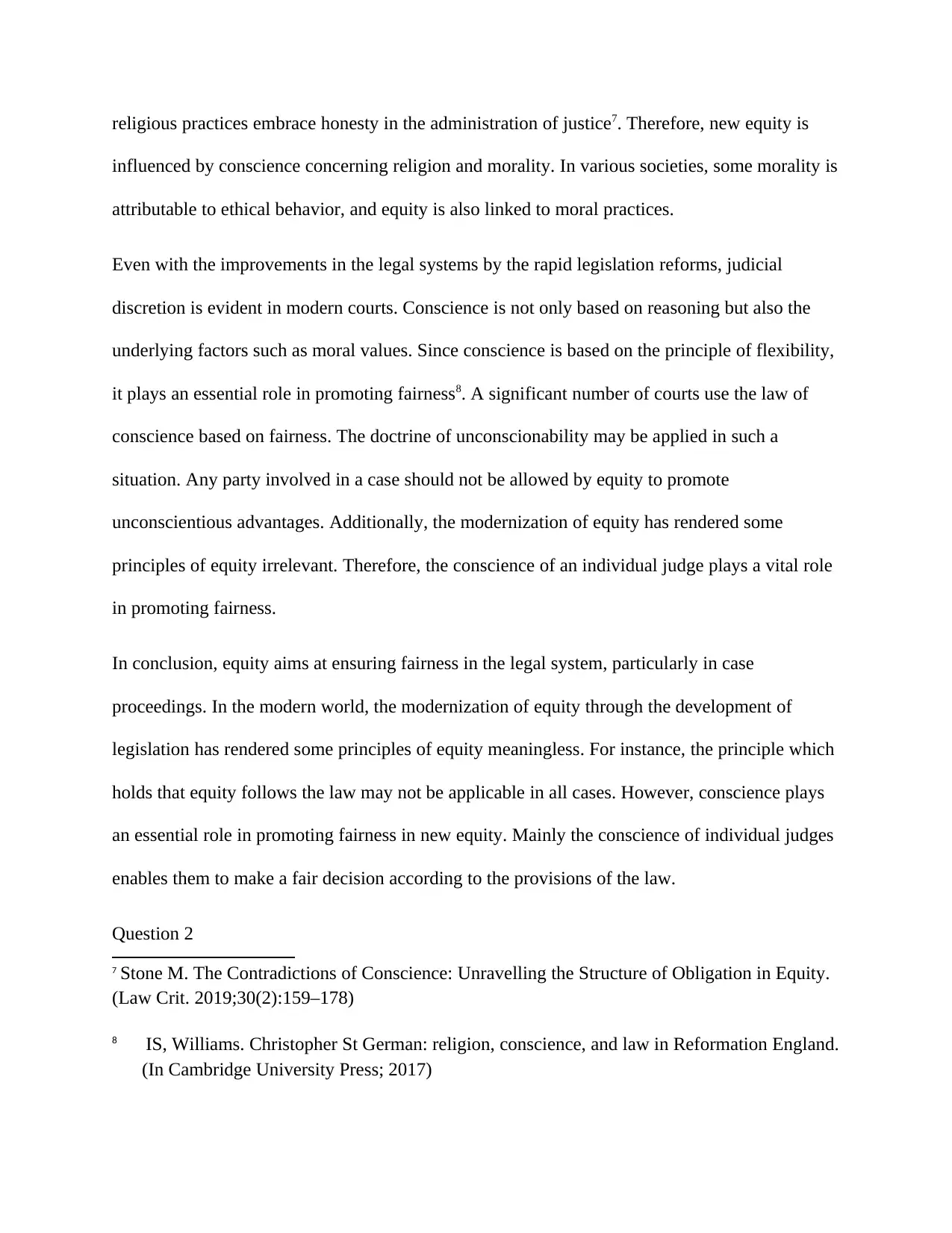
religious practices embrace honesty in the administration of justice7. Therefore, new equity is
influenced by conscience concerning religion and morality. In various societies, some morality is
attributable to ethical behavior, and equity is also linked to moral practices.
Even with the improvements in the legal systems by the rapid legislation reforms, judicial
discretion is evident in modern courts. Conscience is not only based on reasoning but also the
underlying factors such as moral values. Since conscience is based on the principle of flexibility,
it plays an essential role in promoting fairness8. A significant number of courts use the law of
conscience based on fairness. The doctrine of unconscionability may be applied in such a
situation. Any party involved in a case should not be allowed by equity to promote
unconscientious advantages. Additionally, the modernization of equity has rendered some
principles of equity irrelevant. Therefore, the conscience of an individual judge plays a vital role
in promoting fairness.
In conclusion, equity aims at ensuring fairness in the legal system, particularly in case
proceedings. In the modern world, the modernization of equity through the development of
legislation has rendered some principles of equity meaningless. For instance, the principle which
holds that equity follows the law may not be applicable in all cases. However, conscience plays
an essential role in promoting fairness in new equity. Mainly the conscience of individual judges
enables them to make a fair decision according to the provisions of the law.
Question 2
7 Stone M. The Contradictions of Conscience: Unravelling the Structure of Obligation in Equity.
(Law Crit. 2019;30(2):159–178)
8 IS, Williams. Christopher St German: religion, conscience, and law in Reformation England.
(In Cambridge University Press; 2017)
influenced by conscience concerning religion and morality. In various societies, some morality is
attributable to ethical behavior, and equity is also linked to moral practices.
Even with the improvements in the legal systems by the rapid legislation reforms, judicial
discretion is evident in modern courts. Conscience is not only based on reasoning but also the
underlying factors such as moral values. Since conscience is based on the principle of flexibility,
it plays an essential role in promoting fairness8. A significant number of courts use the law of
conscience based on fairness. The doctrine of unconscionability may be applied in such a
situation. Any party involved in a case should not be allowed by equity to promote
unconscientious advantages. Additionally, the modernization of equity has rendered some
principles of equity irrelevant. Therefore, the conscience of an individual judge plays a vital role
in promoting fairness.
In conclusion, equity aims at ensuring fairness in the legal system, particularly in case
proceedings. In the modern world, the modernization of equity through the development of
legislation has rendered some principles of equity meaningless. For instance, the principle which
holds that equity follows the law may not be applicable in all cases. However, conscience plays
an essential role in promoting fairness in new equity. Mainly the conscience of individual judges
enables them to make a fair decision according to the provisions of the law.
Question 2
7 Stone M. The Contradictions of Conscience: Unravelling the Structure of Obligation in Equity.
(Law Crit. 2019;30(2):159–178)
8 IS, Williams. Christopher St German: religion, conscience, and law in Reformation England.
(In Cambridge University Press; 2017)

Charities are established to help the vulnerable and needy in society. Many charities are formed
by individuals willing to help in providing essential services to the needy. Even though most
charities are nonprofit making organizations, their establishment should follow the provisions of
the law9. Public benefit requirement is a legal obligation that holds that the primary purpose of a
charity should be a public benefit. Its services should determine the mission of the charity to the
public. Charities strive to benefit society to fulfill their purpose. If a charity organization does
not help the public, it may not be considered to promote public benefit.
According to the Charities Act, the knowledge and experience of public benefit requirements
enable a charity to maintain its brand. In the charity sector, public benefit is perceived to attract
many stakeholders hence maintaining the brand of the particular charity. The public benefit
requirements range from various aspects such as climate and the feeling of anger and anxiety.
Charities should have a skilled and competent board that is aware of the public benefits
requirement10. Studies indicate that large charities are considered to have adequate knowledge on
the public benefit requirement as compared to small charities.
The Charities Commission supports the public benefit requirements to ensure that the charities
operate for the betterment of society. The primary role of the commission is to advise charities
on what they are required to benefit the public. Moreover, the public benefit requirement boosts
people’s confidence in the charity. Since the primary role of charities is to provide essential
9 JL Bell. Governing Commercial Access to Health Data for Public Benefit: Charity Law
Solutions. (Med Law Rev. 2019)
10 K Chan. Public Benefit and the Substantive Public Law-Private Law Divide. (Kathryn Chan
Public-Priv Nat Charity Law Oxf Hart Bloomsbury 2016. 2016)
by individuals willing to help in providing essential services to the needy. Even though most
charities are nonprofit making organizations, their establishment should follow the provisions of
the law9. Public benefit requirement is a legal obligation that holds that the primary purpose of a
charity should be a public benefit. Its services should determine the mission of the charity to the
public. Charities strive to benefit society to fulfill their purpose. If a charity organization does
not help the public, it may not be considered to promote public benefit.
According to the Charities Act, the knowledge and experience of public benefit requirements
enable a charity to maintain its brand. In the charity sector, public benefit is perceived to attract
many stakeholders hence maintaining the brand of the particular charity. The public benefit
requirements range from various aspects such as climate and the feeling of anger and anxiety.
Charities should have a skilled and competent board that is aware of the public benefits
requirement10. Studies indicate that large charities are considered to have adequate knowledge on
the public benefit requirement as compared to small charities.
The Charities Commission supports the public benefit requirements to ensure that the charities
operate for the betterment of society. The primary role of the commission is to advise charities
on what they are required to benefit the public. Moreover, the public benefit requirement boosts
people’s confidence in the charity. Since the primary role of charities is to provide essential
9 JL Bell. Governing Commercial Access to Health Data for Public Benefit: Charity Law
Solutions. (Med Law Rev. 2019)
10 K Chan. Public Benefit and the Substantive Public Law-Private Law Divide. (Kathryn Chan
Public-Priv Nat Charity Law Oxf Hart Bloomsbury 2016. 2016)
⊘ This is a preview!⊘
Do you want full access?
Subscribe today to unlock all pages.

Trusted by 1+ million students worldwide
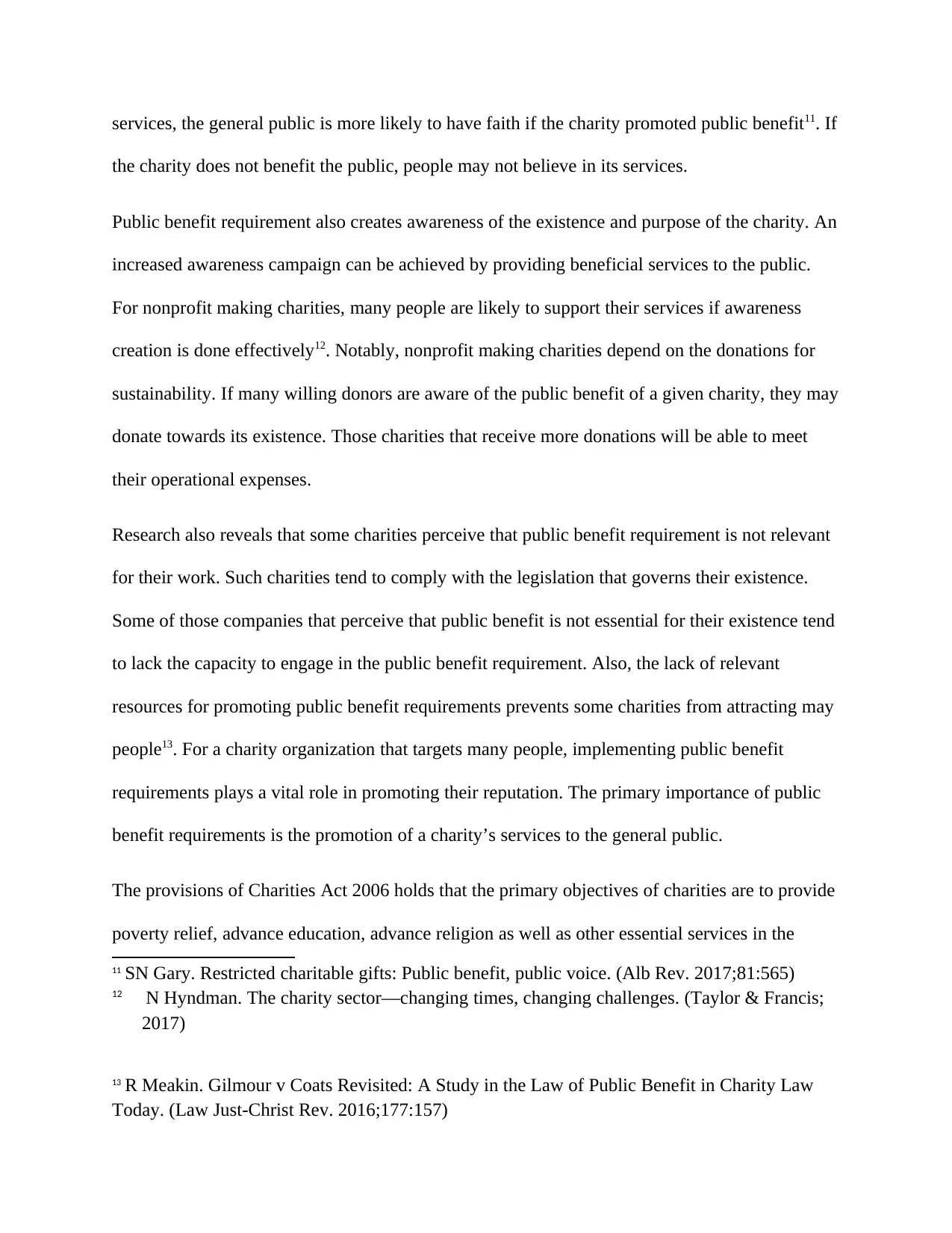
services, the general public is more likely to have faith if the charity promoted public benefit11. If
the charity does not benefit the public, people may not believe in its services.
Public benefit requirement also creates awareness of the existence and purpose of the charity. An
increased awareness campaign can be achieved by providing beneficial services to the public.
For nonprofit making charities, many people are likely to support their services if awareness
creation is done effectively12. Notably, nonprofit making charities depend on the donations for
sustainability. If many willing donors are aware of the public benefit of a given charity, they may
donate towards its existence. Those charities that receive more donations will be able to meet
their operational expenses.
Research also reveals that some charities perceive that public benefit requirement is not relevant
for their work. Such charities tend to comply with the legislation that governs their existence.
Some of those companies that perceive that public benefit is not essential for their existence tend
to lack the capacity to engage in the public benefit requirement. Also, the lack of relevant
resources for promoting public benefit requirements prevents some charities from attracting may
people13. For a charity organization that targets many people, implementing public benefit
requirements plays a vital role in promoting their reputation. The primary importance of public
benefit requirements is the promotion of a charity’s services to the general public.
The provisions of Charities Act 2006 holds that the primary objectives of charities are to provide
poverty relief, advance education, advance religion as well as other essential services in the
11 SN Gary. Restricted charitable gifts: Public benefit, public voice. (Alb Rev. 2017;81:565)
12 N Hyndman. The charity sector—changing times, changing challenges. (Taylor & Francis;
2017)
13 R Meakin. Gilmour v Coats Revisited: A Study in the Law of Public Benefit in Charity Law
Today. (Law Just-Christ Rev. 2016;177:157)
the charity does not benefit the public, people may not believe in its services.
Public benefit requirement also creates awareness of the existence and purpose of the charity. An
increased awareness campaign can be achieved by providing beneficial services to the public.
For nonprofit making charities, many people are likely to support their services if awareness
creation is done effectively12. Notably, nonprofit making charities depend on the donations for
sustainability. If many willing donors are aware of the public benefit of a given charity, they may
donate towards its existence. Those charities that receive more donations will be able to meet
their operational expenses.
Research also reveals that some charities perceive that public benefit requirement is not relevant
for their work. Such charities tend to comply with the legislation that governs their existence.
Some of those companies that perceive that public benefit is not essential for their existence tend
to lack the capacity to engage in the public benefit requirement. Also, the lack of relevant
resources for promoting public benefit requirements prevents some charities from attracting may
people13. For a charity organization that targets many people, implementing public benefit
requirements plays a vital role in promoting their reputation. The primary importance of public
benefit requirements is the promotion of a charity’s services to the general public.
The provisions of Charities Act 2006 holds that the primary objectives of charities are to provide
poverty relief, advance education, advance religion as well as other essential services in the
11 SN Gary. Restricted charitable gifts: Public benefit, public voice. (Alb Rev. 2017;81:565)
12 N Hyndman. The charity sector—changing times, changing challenges. (Taylor & Francis;
2017)
13 R Meakin. Gilmour v Coats Revisited: A Study in the Law of Public Benefit in Charity Law
Today. (Law Just-Christ Rev. 2016;177:157)
Paraphrase This Document
Need a fresh take? Get an instant paraphrase of this document with our AI Paraphraser
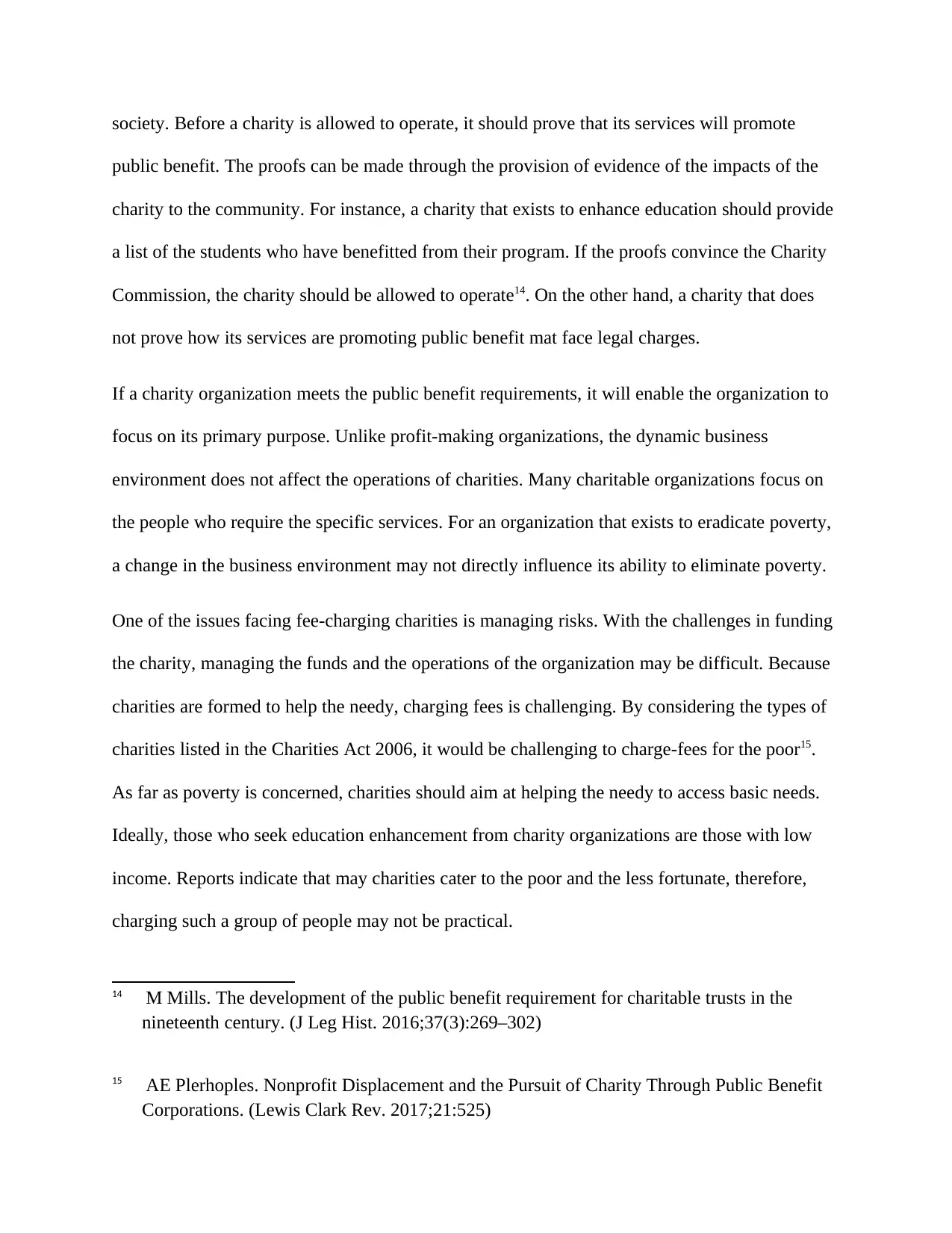
society. Before a charity is allowed to operate, it should prove that its services will promote
public benefit. The proofs can be made through the provision of evidence of the impacts of the
charity to the community. For instance, a charity that exists to enhance education should provide
a list of the students who have benefitted from their program. If the proofs convince the Charity
Commission, the charity should be allowed to operate14. On the other hand, a charity that does
not prove how its services are promoting public benefit mat face legal charges.
If a charity organization meets the public benefit requirements, it will enable the organization to
focus on its primary purpose. Unlike profit-making organizations, the dynamic business
environment does not affect the operations of charities. Many charitable organizations focus on
the people who require the specific services. For an organization that exists to eradicate poverty,
a change in the business environment may not directly influence its ability to eliminate poverty.
One of the issues facing fee-charging charities is managing risks. With the challenges in funding
the charity, managing the funds and the operations of the organization may be difficult. Because
charities are formed to help the needy, charging fees is challenging. By considering the types of
charities listed in the Charities Act 2006, it would be challenging to charge-fees for the poor15.
As far as poverty is concerned, charities should aim at helping the needy to access basic needs.
Ideally, those who seek education enhancement from charity organizations are those with low
income. Reports indicate that may charities cater to the poor and the less fortunate, therefore,
charging such a group of people may not be practical.
14 M Mills. The development of the public benefit requirement for charitable trusts in the
nineteenth century. (J Leg Hist. 2016;37(3):269–302)
15 AE Plerhoples. Nonprofit Displacement and the Pursuit of Charity Through Public Benefit
Corporations. (Lewis Clark Rev. 2017;21:525)
public benefit. The proofs can be made through the provision of evidence of the impacts of the
charity to the community. For instance, a charity that exists to enhance education should provide
a list of the students who have benefitted from their program. If the proofs convince the Charity
Commission, the charity should be allowed to operate14. On the other hand, a charity that does
not prove how its services are promoting public benefit mat face legal charges.
If a charity organization meets the public benefit requirements, it will enable the organization to
focus on its primary purpose. Unlike profit-making organizations, the dynamic business
environment does not affect the operations of charities. Many charitable organizations focus on
the people who require the specific services. For an organization that exists to eradicate poverty,
a change in the business environment may not directly influence its ability to eliminate poverty.
One of the issues facing fee-charging charities is managing risks. With the challenges in funding
the charity, managing the funds and the operations of the organization may be difficult. Because
charities are formed to help the needy, charging fees is challenging. By considering the types of
charities listed in the Charities Act 2006, it would be challenging to charge-fees for the poor15.
As far as poverty is concerned, charities should aim at helping the needy to access basic needs.
Ideally, those who seek education enhancement from charity organizations are those with low
income. Reports indicate that may charities cater to the poor and the less fortunate, therefore,
charging such a group of people may not be practical.
14 M Mills. The development of the public benefit requirement for charitable trusts in the
nineteenth century. (J Leg Hist. 2016;37(3):269–302)
15 AE Plerhoples. Nonprofit Displacement and the Pursuit of Charity Through Public Benefit
Corporations. (Lewis Clark Rev. 2017;21:525)
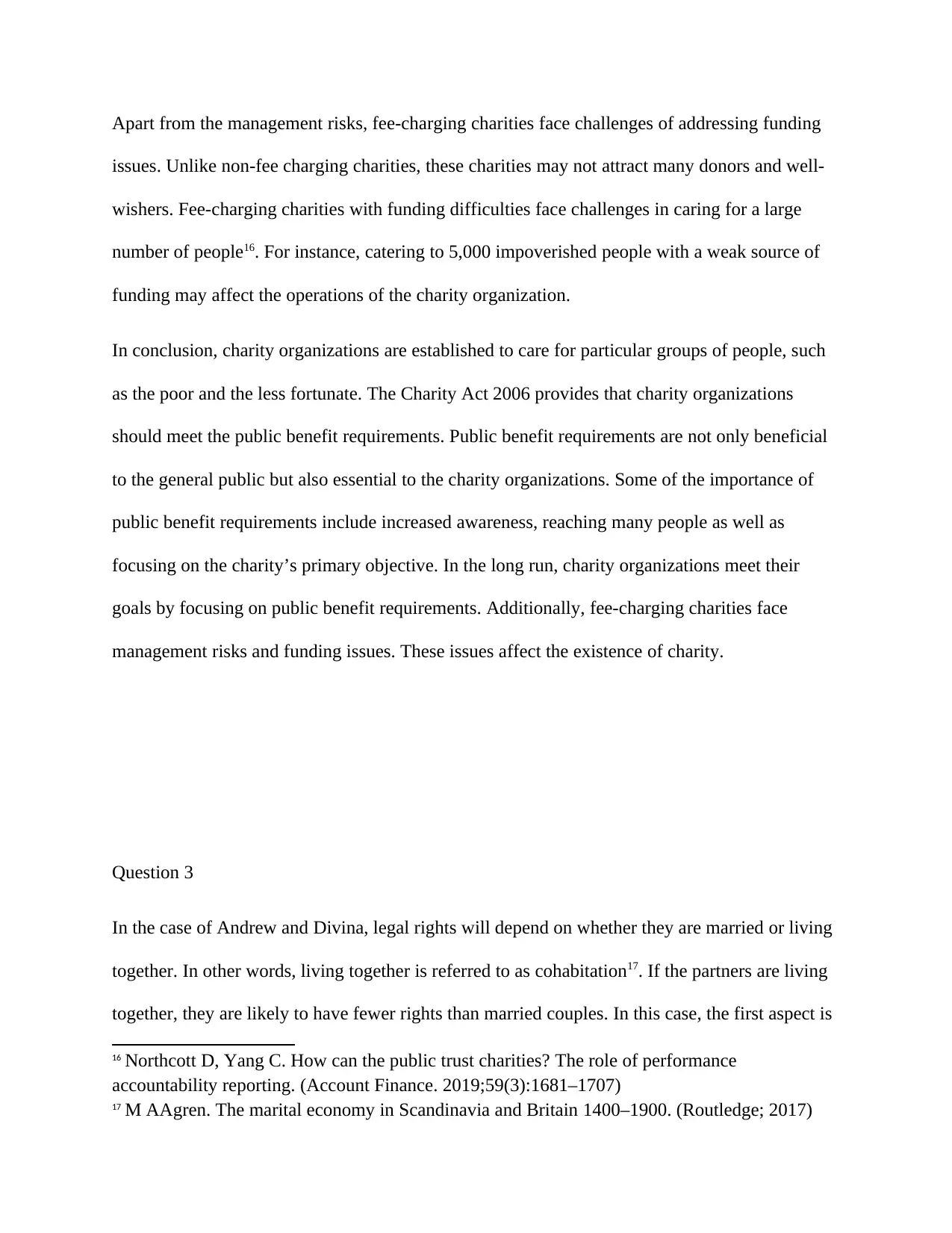
Apart from the management risks, fee-charging charities face challenges of addressing funding
issues. Unlike non-fee charging charities, these charities may not attract many donors and well-
wishers. Fee-charging charities with funding difficulties face challenges in caring for a large
number of people16. For instance, catering to 5,000 impoverished people with a weak source of
funding may affect the operations of the charity organization.
In conclusion, charity organizations are established to care for particular groups of people, such
as the poor and the less fortunate. The Charity Act 2006 provides that charity organizations
should meet the public benefit requirements. Public benefit requirements are not only beneficial
to the general public but also essential to the charity organizations. Some of the importance of
public benefit requirements include increased awareness, reaching many people as well as
focusing on the charity’s primary objective. In the long run, charity organizations meet their
goals by focusing on public benefit requirements. Additionally, fee-charging charities face
management risks and funding issues. These issues affect the existence of charity.
Question 3
In the case of Andrew and Divina, legal rights will depend on whether they are married or living
together. In other words, living together is referred to as cohabitation17. If the partners are living
together, they are likely to have fewer rights than married couples. In this case, the first aspect is
16 Northcott D, Yang C. How can the public trust charities? The role of performance
accountability reporting. (Account Finance. 2019;59(3):1681–1707)
17 M AAgren. The marital economy in Scandinavia and Britain 1400–1900. (Routledge; 2017)
issues. Unlike non-fee charging charities, these charities may not attract many donors and well-
wishers. Fee-charging charities with funding difficulties face challenges in caring for a large
number of people16. For instance, catering to 5,000 impoverished people with a weak source of
funding may affect the operations of the charity organization.
In conclusion, charity organizations are established to care for particular groups of people, such
as the poor and the less fortunate. The Charity Act 2006 provides that charity organizations
should meet the public benefit requirements. Public benefit requirements are not only beneficial
to the general public but also essential to the charity organizations. Some of the importance of
public benefit requirements include increased awareness, reaching many people as well as
focusing on the charity’s primary objective. In the long run, charity organizations meet their
goals by focusing on public benefit requirements. Additionally, fee-charging charities face
management risks and funding issues. These issues affect the existence of charity.
Question 3
In the case of Andrew and Divina, legal rights will depend on whether they are married or living
together. In other words, living together is referred to as cohabitation17. If the partners are living
together, they are likely to have fewer rights than married couples. In this case, the first aspect is
16 Northcott D, Yang C. How can the public trust charities? The role of performance
accountability reporting. (Account Finance. 2019;59(3):1681–1707)
17 M AAgren. The marital economy in Scandinavia and Britain 1400–1900. (Routledge; 2017)
⊘ This is a preview!⊘
Do you want full access?
Subscribe today to unlock all pages.

Trusted by 1+ million students worldwide
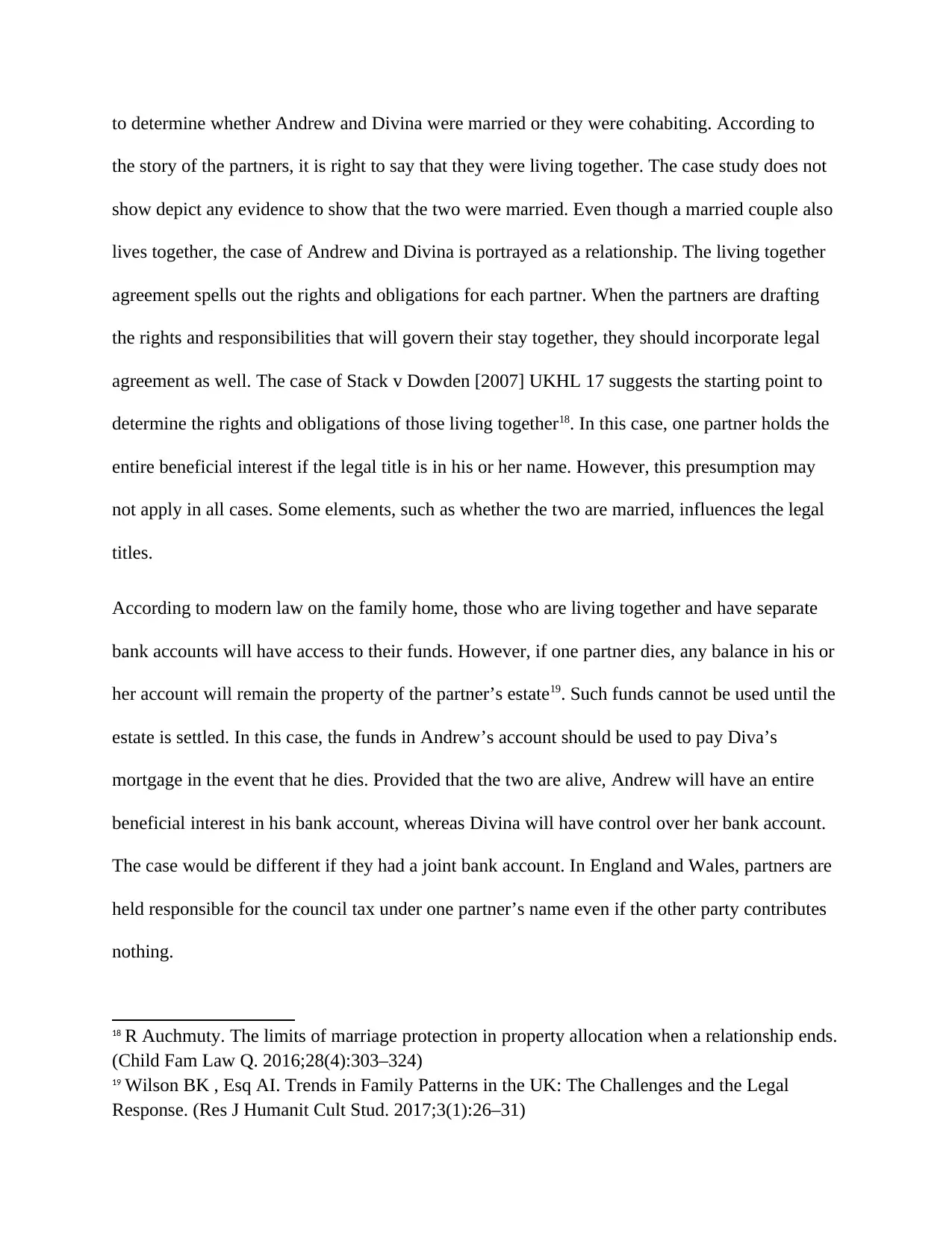
to determine whether Andrew and Divina were married or they were cohabiting. According to
the story of the partners, it is right to say that they were living together. The case study does not
show depict any evidence to show that the two were married. Even though a married couple also
lives together, the case of Andrew and Divina is portrayed as a relationship. The living together
agreement spells out the rights and obligations for each partner. When the partners are drafting
the rights and responsibilities that will govern their stay together, they should incorporate legal
agreement as well. The case of Stack v Dowden [2007] UKHL 17 suggests the starting point to
determine the rights and obligations of those living together18. In this case, one partner holds the
entire beneficial interest if the legal title is in his or her name. However, this presumption may
not apply in all cases. Some elements, such as whether the two are married, influences the legal
titles.
According to modern law on the family home, those who are living together and have separate
bank accounts will have access to their funds. However, if one partner dies, any balance in his or
her account will remain the property of the partner’s estate19. Such funds cannot be used until the
estate is settled. In this case, the funds in Andrew’s account should be used to pay Diva’s
mortgage in the event that he dies. Provided that the two are alive, Andrew will have an entire
beneficial interest in his bank account, whereas Divina will have control over her bank account.
The case would be different if they had a joint bank account. In England and Wales, partners are
held responsible for the council tax under one partner’s name even if the other party contributes
nothing.
18 R Auchmuty. The limits of marriage protection in property allocation when a relationship ends.
(Child Fam Law Q. 2016;28(4):303–324)
19 Wilson BK , Esq AI. Trends in Family Patterns in the UK: The Challenges and the Legal
Response. (Res J Humanit Cult Stud. 2017;3(1):26–31)
the story of the partners, it is right to say that they were living together. The case study does not
show depict any evidence to show that the two were married. Even though a married couple also
lives together, the case of Andrew and Divina is portrayed as a relationship. The living together
agreement spells out the rights and obligations for each partner. When the partners are drafting
the rights and responsibilities that will govern their stay together, they should incorporate legal
agreement as well. The case of Stack v Dowden [2007] UKHL 17 suggests the starting point to
determine the rights and obligations of those living together18. In this case, one partner holds the
entire beneficial interest if the legal title is in his or her name. However, this presumption may
not apply in all cases. Some elements, such as whether the two are married, influences the legal
titles.
According to modern law on the family home, those who are living together and have separate
bank accounts will have access to their funds. However, if one partner dies, any balance in his or
her account will remain the property of the partner’s estate19. Such funds cannot be used until the
estate is settled. In this case, the funds in Andrew’s account should be used to pay Diva’s
mortgage in the event that he dies. Provided that the two are alive, Andrew will have an entire
beneficial interest in his bank account, whereas Divina will have control over her bank account.
The case would be different if they had a joint bank account. In England and Wales, partners are
held responsible for the council tax under one partner’s name even if the other party contributes
nothing.
18 R Auchmuty. The limits of marriage protection in property allocation when a relationship ends.
(Child Fam Law Q. 2016;28(4):303–324)
19 Wilson BK , Esq AI. Trends in Family Patterns in the UK: The Challenges and the Legal
Response. (Res J Humanit Cult Stud. 2017;3(1):26–31)
Paraphrase This Document
Need a fresh take? Get an instant paraphrase of this document with our AI Paraphraser

Since Andrew and Divina are living together as an unmarried couple, Andrew will have limited
rights on Divina’s property. According to the law on marriage and home in the UK, an unmarried
couple can end their relationship informally without the interventions of the legal system20.
When Andrew and Divina ended their relationship indefinitely, one party could not take legal
action. Unlike married couples, ending a relationship is considered as divorce. In many
countries, including Latin America, divorce is settled in courts where the partners can share their
properties. In this regard, Andrew will not have a legal title on Divina’s property unless they are
married.
The law also provides that those who are living together do not have a legal duty to support their
partner’s finances. However, one party can volunteer to pay for the maintenance of the property.
Even though Andrew was paying rent in his house after the breakup, he has no legal duty to fund
Divina’s mortgage21. Therefore, Divina cannot take legal action on Andrew for not servicing the
loan despite living in the same house. The law on marriage holds that each married partner has a
legal duty to support each other financially or by any other means. Andrew has control over the
house that he was renting; however, he would not have the right to stay if the landlord tells him
to leave.
The UK marriage law also states that if a cohabiting couple breaks up, the ownership of the
house remains on the person that the title right bears their name. However, the partner can show
that he owns the house provided that he contributed to the purchase of the home22. In the case of
Andrew and Divina, there is no evidence that Andrew contributed to the purchase of the home.
20 Glennon L, Gilmore S. Hayes and Williams’ family law. (Oxford University Press, USA;
2018)
21 Köppe S, Izuhara M. Inheritance and family conflicts: exploring asset transfers shaping
intergenerational relations. (Fam Relatsh Soc. 2019;8(1):53–72)
rights on Divina’s property. According to the law on marriage and home in the UK, an unmarried
couple can end their relationship informally without the interventions of the legal system20.
When Andrew and Divina ended their relationship indefinitely, one party could not take legal
action. Unlike married couples, ending a relationship is considered as divorce. In many
countries, including Latin America, divorce is settled in courts where the partners can share their
properties. In this regard, Andrew will not have a legal title on Divina’s property unless they are
married.
The law also provides that those who are living together do not have a legal duty to support their
partner’s finances. However, one party can volunteer to pay for the maintenance of the property.
Even though Andrew was paying rent in his house after the breakup, he has no legal duty to fund
Divina’s mortgage21. Therefore, Divina cannot take legal action on Andrew for not servicing the
loan despite living in the same house. The law on marriage holds that each married partner has a
legal duty to support each other financially or by any other means. Andrew has control over the
house that he was renting; however, he would not have the right to stay if the landlord tells him
to leave.
The UK marriage law also states that if a cohabiting couple breaks up, the ownership of the
house remains on the person that the title right bears their name. However, the partner can show
that he owns the house provided that he contributed to the purchase of the home22. In the case of
Andrew and Divina, there is no evidence that Andrew contributed to the purchase of the home.
20 Glennon L, Gilmore S. Hayes and Williams’ family law. (Oxford University Press, USA;
2018)
21 Köppe S, Izuhara M. Inheritance and family conflicts: exploring asset transfers shaping
intergenerational relations. (Fam Relatsh Soc. 2019;8(1):53–72)
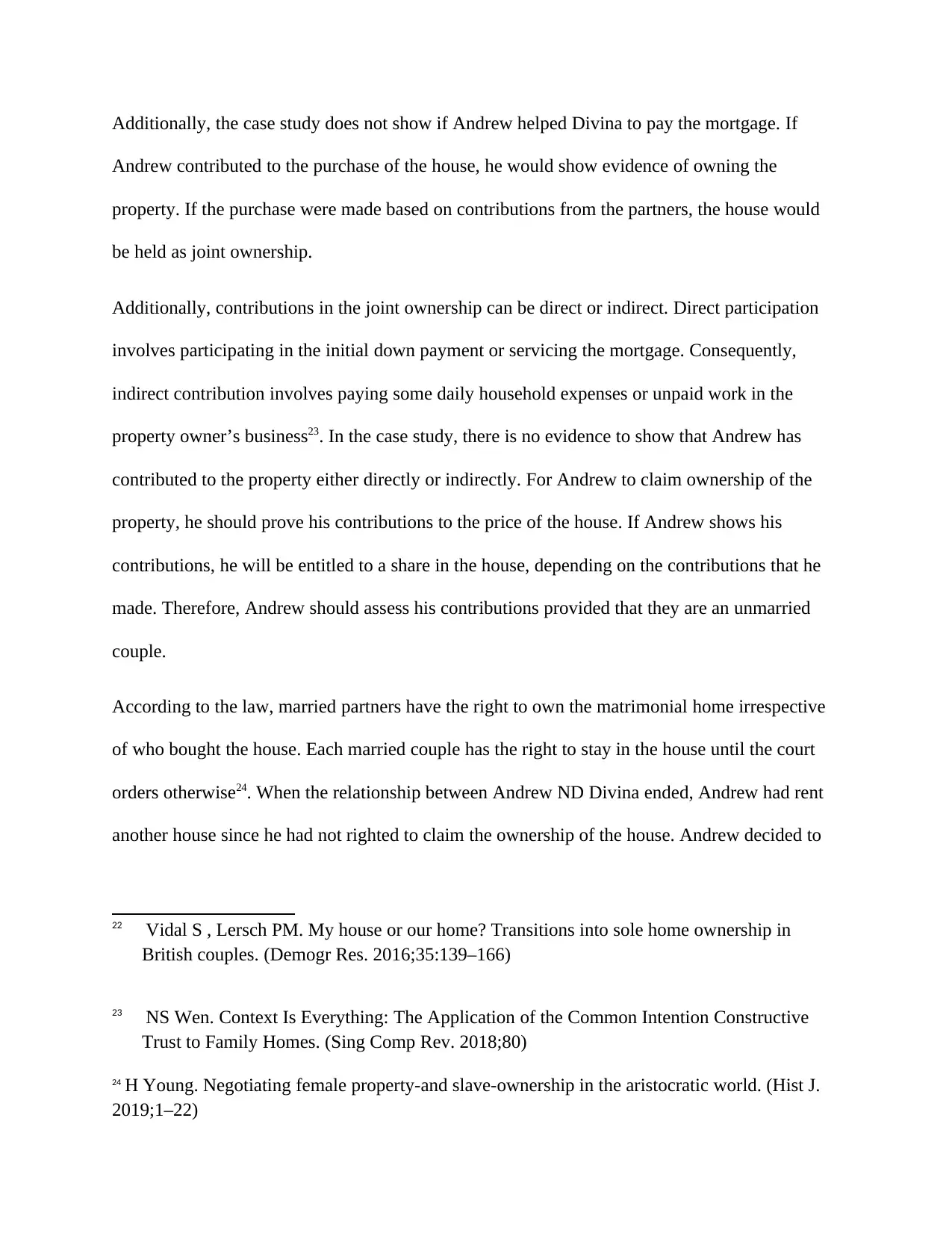
Additionally, the case study does not show if Andrew helped Divina to pay the mortgage. If
Andrew contributed to the purchase of the house, he would show evidence of owning the
property. If the purchase were made based on contributions from the partners, the house would
be held as joint ownership.
Additionally, contributions in the joint ownership can be direct or indirect. Direct participation
involves participating in the initial down payment or servicing the mortgage. Consequently,
indirect contribution involves paying some daily household expenses or unpaid work in the
property owner’s business23. In the case study, there is no evidence to show that Andrew has
contributed to the property either directly or indirectly. For Andrew to claim ownership of the
property, he should prove his contributions to the price of the house. If Andrew shows his
contributions, he will be entitled to a share in the house, depending on the contributions that he
made. Therefore, Andrew should assess his contributions provided that they are an unmarried
couple.
According to the law, married partners have the right to own the matrimonial home irrespective
of who bought the house. Each married couple has the right to stay in the house until the court
orders otherwise24. When the relationship between Andrew ND Divina ended, Andrew had rent
another house since he had not righted to claim the ownership of the house. Andrew decided to
22 Vidal S , Lersch PM. My house or our home? Transitions into sole home ownership in
British couples. (Demogr Res. 2016;35:139–166)
23 NS Wen. Context Is Everything: The Application of the Common Intention Constructive
Trust to Family Homes. (Sing Comp Rev. 2018;80)
24 H Young. Negotiating female property-and slave-ownership in the aristocratic world. (Hist J.
2019;1–22)
Andrew contributed to the purchase of the house, he would show evidence of owning the
property. If the purchase were made based on contributions from the partners, the house would
be held as joint ownership.
Additionally, contributions in the joint ownership can be direct or indirect. Direct participation
involves participating in the initial down payment or servicing the mortgage. Consequently,
indirect contribution involves paying some daily household expenses or unpaid work in the
property owner’s business23. In the case study, there is no evidence to show that Andrew has
contributed to the property either directly or indirectly. For Andrew to claim ownership of the
property, he should prove his contributions to the price of the house. If Andrew shows his
contributions, he will be entitled to a share in the house, depending on the contributions that he
made. Therefore, Andrew should assess his contributions provided that they are an unmarried
couple.
According to the law, married partners have the right to own the matrimonial home irrespective
of who bought the house. Each married couple has the right to stay in the house until the court
orders otherwise24. When the relationship between Andrew ND Divina ended, Andrew had rent
another house since he had not righted to claim the ownership of the house. Andrew decided to
22 Vidal S , Lersch PM. My house or our home? Transitions into sole home ownership in
British couples. (Demogr Res. 2016;35:139–166)
23 NS Wen. Context Is Everything: The Application of the Common Intention Constructive
Trust to Family Homes. (Sing Comp Rev. 2018;80)
24 H Young. Negotiating female property-and slave-ownership in the aristocratic world. (Hist J.
2019;1–22)
⊘ This is a preview!⊘
Do you want full access?
Subscribe today to unlock all pages.

Trusted by 1+ million students worldwide
1 out of 16
Related Documents
Your All-in-One AI-Powered Toolkit for Academic Success.
+13062052269
info@desklib.com
Available 24*7 on WhatsApp / Email
![[object Object]](/_next/static/media/star-bottom.7253800d.svg)
Unlock your academic potential
Copyright © 2020–2025 A2Z Services. All Rights Reserved. Developed and managed by ZUCOL.





